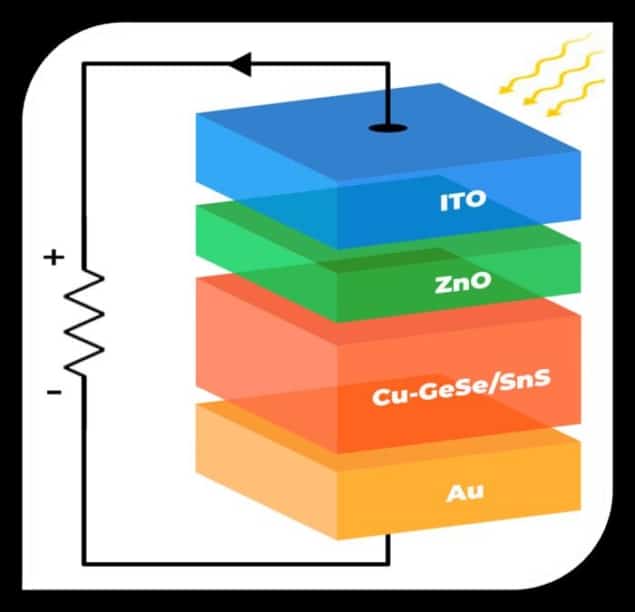
Convention solar cells have a maximum external quantum efficiency (EQE) of 100%: for every photon incident on the cell, they generate one photoexcited electron. In recent years, scientists have sought to improve on this by developing materials that “free up” more than one electron for every photon they absorb. A team led by physicist Chinedu Ekuma of Lehigh University in the US has now achieved this goal, producing a material with an EQE of up to 190% – nearly double that of silicon solar cells.
The team made the new compound by inserting copper atoms between atomically thin layers of germanium selenide (GeSe) and tin sulfide (SnS). The resulting material has the chemical formula CuxGeSe/SnS, and the researchers developed it by taking advantage of so-called van der Waals gaps. These atomically small gaps exist between layers of two-dimensional materials, and they form “pockets” into which other elements can be inserted (or “intercalated”) to tune the material’s properties.
Intermediate bandgap states
The Lehigh researchers attribute the material’s increased EQE to the presence of intermediate bandgap states. These distinct electronic energy levels arise within the material’s electronic structure in a way that enables them to absorb light very efficiently over a broad spectrum of solar radiation wavelengths. In the new material, these energy levels exist at around 0.78 and 1.26 electron volts (eV), which lie within the range over which the material can efficiently absorb sunlight.
The material works particularly well in the infrared and visible regions of the electromagnetic spectrum, producing, on average, nearly two photoexcited charge carriers (electrons and holes bound in quasiparticles known as excitons) for every incident photon. According to Ekuma, such “multiple exciton generation” materials can serve as the active layer within solar cell devices, where their performance is fundamentally governed by exciton physics. “This active layer is crucial for enhancing the solar cell’s efficiency by facilitating the generation and transport of excitons in the material,” Ekuma explains.
Further research needed for practical devices
The researchers used advanced computational models to optimize the thickness of the photoactive layer in the material. They calculated that its EQE can be enhanced by making sure that it remains thin (in the so-called quasi-2D limit) to prevent quantum confinement losses. This is a key factor that affects efficient exciton generation and transport through a process known as nonradiative recombination, in which electrons and holes have time to recombine instead of being whisked apart to produce useful current, Ekuma explains. “By maintaining quantum confinement, we preserve the material’s ability to effectively convert absorbed sunlight into electrical energy and operate at peak efficiency,” he says.

Strain guides the flow of excitons in 2D materials
While the new material is a promising candidate for the development of next-generation, high-efficient solar cells, the researchers acknowledge that further research will be needed before it can be integrated into existing solar energy systems. “We are now further exploring this family of intercalated materials and optimizing their efficiency via various materials engineering processes to this end,” Ekuma tells Physics World.
The study is detailed in Science Advances.



